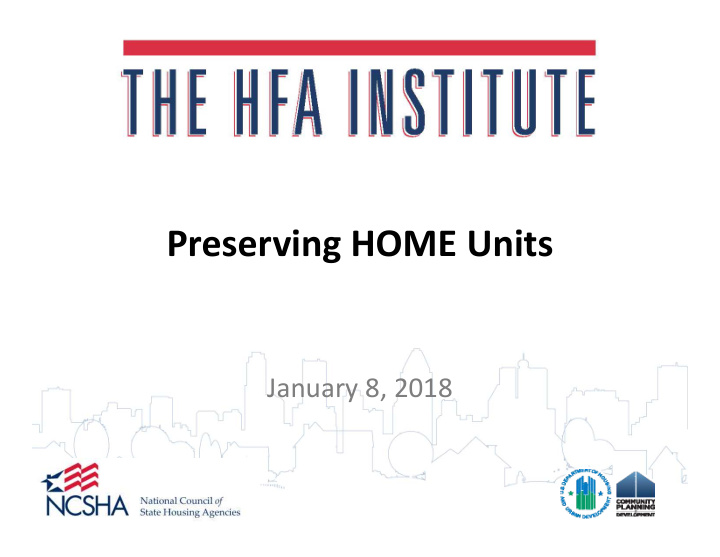



Preserving HOME Units January 8, 2018
Welcome & Introductions • Sponsored by: – HUD’s Office of Affordable Housing Programs – NCSHA • Trainers: – Steve Lathom, TDA Consulting slathom@tdainc.org 517‐203‐4130 – Monte Franke, Franke Consulting Group MLFranke@aol.com Slide 2
HOME Portfolio: Expiring POAs • Program is 25 years old – Many projects have reached end of period of affordability (POA) or soon will – Aging projects likely need rehab – Other project financing may be coming due • LIHTC investor exits • Mortgage financing reaching maturity, often with balloon payment due Slide 3
Production v. Preservation • PJs need to determine relative priority of – New production v. preservation of expiring units • Preservation often attractive – Cost effective, extending affordability often requires less time, money, and effort – Existing projects may be better located – Avoids economic displacement of LI tenants from market conversion • But… growing portfolio/declining resources increases pressure on resources Slide 4
Developing a Preservation Strategy • How much to devote to preservation? • What projects take priority? – CHDO/NP owned, special needs, located in gentrifying or “opportunity” areas, etc. • How to select? – Open applications, identified through monitoring or other assessment, hybrid, other means? Slide 5
Developing Strategy cont… • What costs will you fund? – Acq, rehab, soft costs, dev. fees? – What other funds are available? • How might underwriting guidelines differ? – Requirements use of existing balances/reserves – Owner expectations • POA extension, waive prepayment, etc. – Other funder expectations • Subordination, changes to unit mix, etc. Slide 6
Questions to Ponder • Do you know your portfolio? – How many and which projects/units are expiring • Do you understand their physical and financial condition and needs? • Have you begun to recapitalize projects? – Lesson learned, resources used, etc.? • Is preservation part of your strategy? Slide 7
Portfolio to Project Slide 8
Review Legal Documents • POA measured from IDIS completion – Many older projects were entered late – Confirm actual date • Review original agreement, declaration, and financing docs… – Did they apply a longer affordability period? – Did they provide for local extended use period? – What are the financial terms? Repayable/forgivable? – How are reserves to be distributed/retained? Slide 9
Assess Project Needs • What are the capital needs? • Is non‐HOME debt maturing? – Does is balloon? – Are its existing terms sustainable/attractive? • What is the financial condition? – Are accounts current, reserves funded or depleted? • Is the project still competitive in the market? • Is the owner capable/interested in continued ownership? Slide 10
Develop Preservation Plan • What should the project look like moving forward? – Have needs/priorities changes re: income targeting, special needs, etc.? • How has the project performed financially, physically, within the community? – Are changes beyond rehab/refinancing needed? – Is new ownership or management needed? • Can preservation be accomplished with HOME restructuring (e.g. defer or extend payment) w/out new investment? Slide 11
Define and Underwrite New Project • Rehab only, rehab/refi, acq/rehab – Sale may be to “new” related entity • What new funding is needed? – Esp. given current underwriting guidelines • Treatment of prior HOME – Likely repay, receipt PI, fund new project – Sometimes structured forgiveness • Identify and manage compliance issues – Env. Review, Relocation, LPB, DBRA, etc. Slide 12
Negotiate Restructuring • All parties must participate – May need to provide flexibility or – Waive/forego anticipated returns/fees/etc. • Project must be viable for new POA Slide 13
Next Steps Develop Assess & Portfolio Adjust Approach Do Some Deals Slide 14
Slide 15
Recommend
More recommend